|
|
|
 WHOUY SZE KUINALTH WHOUY SZE KUINALTH
"Teaching Our Many Grandchildren"

Gathering, Traditions & Nutrition
of our Food
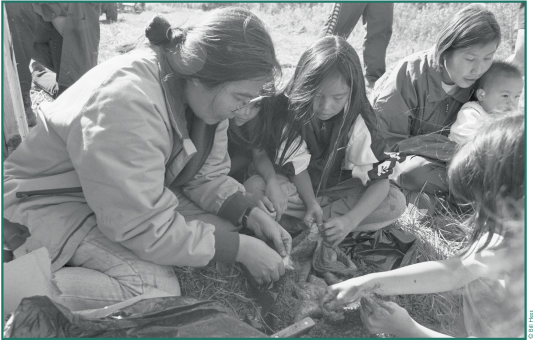
© Bill Hess
Nora David, Lorna David,
Angel Joseph, Jeanette John & baby D'anjelo clean
moose stomach at Batzulnetas, '99.
|
STATE STANDARDS
English/Language Arts
D. A student should be able to think logically and
reflectively in order to present and explain positions
based on relevant and reliable information.
E. A student should understand and respect the perspectives
of others in order to communicate effectively.
Science
B. A student should possess and understand the skills
of scientific inquiry.
History
C. A student should develop the skills and processes
of historical inquiry.
D. A student should be able to integrate historical
knowledge with historical skill to effectively participate
as a citizen and as a lifelong learner.
Skills For A Healthy Lifestyle
A. A student should be able to acquire a core knowledge
related to well-being.
Arts
D. A student should be able to recognize beauty
and meaning through the arts in the student's life.
World Languages
B. A student should expand the student's knowledge
of peoples and cultures through language study.
CULTURAL STANDARDS
A. Culturally-knowledgeable students are well grounded
in the cultural heritage and traditions of their
community.
C. Culturally-knowledgeable students are able to
actively participate in various cultural environments.
D. Culturally-knowledgeable students are able to
engage effectively in learning activities that are
based on traditional ways of knowing and learning.
E. Culturally-knowledgeable students demonstrate
an awareness and appreciation of the relationships
and processes of interaction of all elements in the
world around them.
|
FURTHER RESOURCES FOR RESEARCH
AND ACTIVITIES
- National Institute of Nutrition
- http://www.nin.ca/Publications/HealthyBites/hb3_94en.html
- Alaska Native Knowledge Network
- ankn.uaf.edu/
- Subsistence board game and curriculum
- Alaska Rural Systemic Initiative
- South Central Foundation
- http://www.southcentralfoundation.org/
- Alaska Native Health Board www.anhb.org
- Association of American Indian Physicians
- www.aaip.org
- National Diabetes Education Program, a joint
program of NIH and CDC
- http://www.ndep.nih.gov ,http://www.cdc.gov/diabetes/projects/ndeps.htm
- http://www.cdc.gov/team-ndep
- Institute of Social and Economic Research
- University of Alaska Anchorage, 3211
- Providence Drive, Anchorage, AK 99508
- Fish and Wildlife service project where kids
partake in the harvest
- http://www.fws.gov/
FOR FURTHER INFORMATION AND
CURRICULUM RESOURCES ON PLANTS:
Mathews,Donna. Unangam Hitnisangisl Aleut
A Region-Based Plant Curriculum for Grades 4-6. Pilot
Edition. Alaska Native Knowledge Network
http://ankn.uaf.edu/Unangam/
|
|
OBJECTIVES
Students will:
1. gain a better understanding of the traditional
gathering and preparations of the traditional food
chain.
2. interact with Elders and knowledgeable community
members to gain pertinent information.
3. develop group skills.
4. compare and contrast nutrients in local foods.
5. develop language skills.
6. learn about germs and how to keep food safe from
spoiling.
|
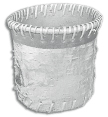 Teacher
Note: Teacher
Note:
Observation is a very powerful tool traditionally used
in teaching children how to be self-sufficient and resourceful.
Whenever possible, make time for the lessons to be located
in a setting most fitted for the sharing to take place.
Wildlife toxicology is a recent focus of concern and
research in the Arctic and Subarctic regions of the world.
Due to the increase in toxicity as contaminants climb the
food chain, more research is being done on toxins in traditional
foods. Many communities throughout these regions have noticed
changes in the condition of their food for many years.
The research will help us understand to what extent these
toxins are affecting the traditional food sources and how
they may affect the communities that rely on these traditional
foods for subsistence and cultural integrity. For information,
visit The Alaska Action on Toxics website www.akaction.net.
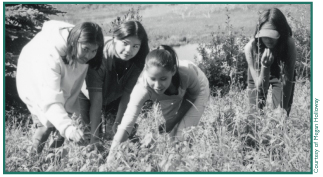
Courtesy of Megan Holloway
Mentasta students Dawn Marie
Rice, Genevie Goodlataw, Jodi Chinuhuk and Challista Sabon
gather raspberries for use in various traditional foods.
|
Lesson
GRADES K -12
Activities:
GATHERING Nilkenazila
1. Ask the students to consider all the foods that
your community members gather throughout the year.
As a class, expand on the chart from the previous
chapter by including the following categories:
* What is used in preparation of these
foods?
* What time of year is the food gathered?
* How is the food prepared for different seasons,
Potlatch and events?
* Who gathers the food? Who prepares it for
different seasons?
* There are specific people that have different
roles in gathering and preparing food? Who are
they and what are the different roles?
* What do you know about eating or not eating
specific foods at specific times? Are there special
foods for the Elders? What are they?
2. Ask for an Elder to speak to the students about
gathering food and preparing food. How does one gain
a sense of pride and respect for the water, land
and animals? What are the customs in the outdoors?
Are there foods you should eat or should not eat
at certain times? Is there a certain way to be and
to act? Should these practices be part of every day?
How can the students learn these ways? Guide the
students to write down some of the guidelines for
further discussion as a class.
3. Ask for an Elder and/or community member to teach
students how to set up a snare. Make enough time
to include finding signs of animal activity in the
snow, such as tracks, caches or trails. Return to
the snare later and continue per tradition.
4. Ask the students to consider any relationships
they know of between animals. Are there stories that
help them to understand these relationships? Are
there ways of listening or watching that can help
to find a moose during hunting season? If so, what
are they? What animals and birds help "tell" us about
other animals, birds or fish? For example, Raven
has two ways of talking, or two songs. One song let's
us know about bear and the other lets us know about
moose. Other birds have songs or calls that help
us know something. What are they?
|
|
 Teacher
Note: Teacher
Note:
Students may have a lot of questions
about the historical and current practices.
Guide the students to write down any questions
they have and discuss the answers with
Elders and community members.
There are very strong beliefs associated
with what is done and what is not done
that are included when teaching or sharing
information. We expect for these "codes" to
be included in this discussion with an
Elder.
|
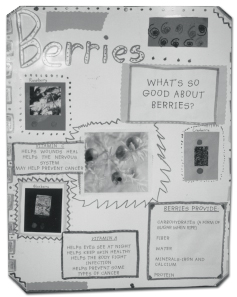
|
|
|
 Teacher
Note: Teacher
Note:
Vitamin C is essential for maintaining a strong
immune system, helping the body absorb iron and
keeping the teeth and gums healthy. Berries have
always been an important subsistence food stored
for winter and are recognized as a necessary part
of the diet. Small amounts of rose hips and berries
provide 100% of the recommended daily Vitamin C
intake. Wild Potato or "roots" contain Vitamin
C and are an important source of energy available
in the spring and fall.
Calcium is found in traditionally prepared fish
and game, leafy green vegetables and dairy products.
It is an important part of the diet for supporting
growth of the skeletal system and teeth. Young
women should include calcium in their diet to prevent
osteoporosis as they get older. Calcium also helps
general physiological systems. It is a vital part
of muscle function, helps maintain a healthy nervous
system and helps maintain normal blood clotting.
Moose play a very important role in our lives.
Moose meat is very good for us and helps us maintain
our traditions. The moose eats leaves and grasses
in the summer and primarily willow branches in
the winter. Moose fat is leaner than store-bought
cattle meat and has essential fatty acids that
are good for us and important for long-term health.
These essential fatty acids are lacking in store-bought
beef. Beef is usually fatty due to the cattle's
concentrated diet of corn, a substance unfitted
for their four-stomach anatomy. Most cows are fed
a combination of hay and corn. Cows fed only grasses
have much leaner meat that contains the same healthy
fatty acids as the moose meat contains. Many cows
are also induced with hormones to stimulate their
growth.
Students should understand that fat is an essential
part of their diet. Fat stored in our bodies is
used for insulation, connective tissues and as
energy when needed. Fat is also always around the
heart and vital organs. It helps insulate our muscles
and forms a portion of our brains. Simple carbohydrates
such as candy and soda can be quickly turned into
fat and stored for future energy use. Intake of
too many simple carbohydrates in a diet can be
hard to your system and has been shown to be a
cause of obesity and late-onset diabetes.
The Alaska Food Guide Pyramid contains foods
commonly available for Alaskans in rural areas.
The food guide pyramid is organized to promote
the same dietary guidelines for every American.
According to the health department, the pyramid
is a way to help Americans maintain a healthy diet
that includes all the necessary nutrients. These
guidelines are possibly unfitting for Native Alaskans
whose primary subsistence foods are meat and plant
roots, greens and berries. In discussing the pyramid,
it may be helpful to refer to the chart from the "Gathering
1" section to help the students consider what foods
are traditionally part of their diet in the greatest
proportions. You may want to have the students
brainstorm another way to draw a chart to help
them organize a healthy diet for themselves and
their community. They should, of course, include
foods that are available from local stores and
that are a part of their current diet.
|
NUTRITION C'aans
gheli y'aan
Research the nutrients that are found in local foods.
Refer to the Alaska Native Science Commission data
on traditional foods for students to do comparative
analyses at:
http://www.nativeknowledge.org/start.htm
For additional resources or information, contact:
Alaska Native Science Commission
3211 Providence Drive, Anchorage, AK 99508
Ph. 907-286-7702
- Which berries do you eat most? How much vitamin
C do they have? Why is vitamin C important?
- What traditional foods are high in calcium? Why
is calcium an important part of your diet?
- Take a short walk to find and talk about the
plants moose eat. How does this compare to what
cattle eat? Why is it important to know what the
food you eat, eats? Referring to the nutrient tables
for the moose and cattle, discuss the role of fat
in our diet. Why is fat important? Where is it
stored? How is the moose fat different than the
cattle fat?
- Refer to the Alaska Food Guide Pyramid at the
end of the chapter. Discuss the pros and cons of
the Food Guide Pyramid as a resource. Is it a good
resource to follow? Does it fit your community
needs?
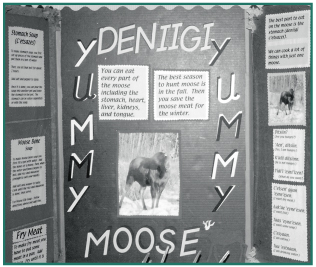
|
Elders Laura Hancock, Lena
Charley, Ruby Sinyon and Johnny Nicolai at a Potlatch
in Chistochina, 2002.
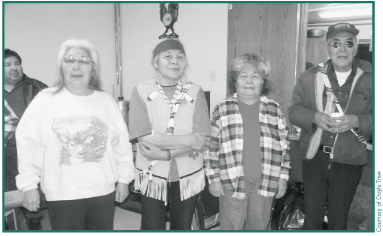
Courtesy of
Doyle Traw
|
 Teacher
Note: Teacher
Note:
Bacteria are unicellular microorganisms with
many diverse environments. They pose a threat to
human populations when a harmful strain of bacteria
is introduced to the right conditions for growth.
Food placed in plastic containers needs to be cooled
quickly because closed plastic containers provide
the optimal conditions for bacterial growth.
Bacteria also live in our mouths. Some of the
bacteria form a sticky coating of plaque that helps
them to adhere to our teeth. These bacteria help
cause cavities by eating the sugars left on our
teeth after a snack or meal. They then produce
an acid that is potent enough to dissolve the hard
enamel that covers our teeth.
The same bacteria found in yogurt live in our
intestines and are very important for us to have
in our bodies. They help us break down food so
we can absorb the nutrients for important physiological
functions.
Viruses are parasitic and cannot be controlled
or treated with antibiotics. They too can cause
serious illnesses that our bodies must fight with
its own defenses.
Bacteria websites for further research:
http://www.ucmp.berkeley.edu/bacteria/bacteria.html
http://www.nationalgeographic.com/ngkids/0010/bacteria/
|
TAKE CARE OF FOOD C'aan
k'ahl taa'
Germs are everywhere! Introduce the subject by explaining
the difference between bacteria and viruses. Bacteria
and viruses are in our bodies, on our bodies, in
the air and on every surface we touch. Some bacteria
are helpful and some bacteria can make us really
sick. Given the right conditions of warmth and moisture,
bacteria will grow and divide very quickly.
- Brainstorm with students various conditions in
the Village that are moist and warm where bacteria
might live and reproduce. What is food poisoning?
Do you know anyone who has ever had "food poisoning"?
What happened? Complete the Bacteria Productivity
activity with the students.
- What were some of the traditional storage methods
for storing food? Talk to an Elder or a knowledgeable
community member about preparing food for winter.
Have the practices changed? If so, how have they
changed? Consider, especially, the use of smoke
and salt for drying and curing meats. What role
does salt have in keeping food healthy?
- Ask what happens to the leftover food at community
dinners, Potlatches and celebrations. What storage
containers were used in the past and what containers
are used now? How might this affect bacterial growth?
- Ask students if bacteria are ever used to make
food taste good. Talk about how yogurt is made
by growing bacteria in milk. Where does helpful
bacteria live? Why is it important to us? "Stinkhead" is
another food made with bacterial help. How is it
made?
- Ask for an Elder or community member to show
the kids how to make fish oil.
- How did your Elders keep their teeth healthy?
How did their diet help keep their teeth healthy?
Are there plants that help keep teeth clean? Did
eating dry meat and dry fish help?
|
|
BACTERIA PRODUCTIVITY
EXAMPLE:
Using Skittles or any
variation of colored candy, show the students
the rater of division of bacteria. For this
example, the bacteria divide every 15-20 minutes.
Place candy in separate bags according to the
table below.
|
Bag #
|
Candy #
|
|
1
|
1
|
|
2
|
2
|
|
3
|
4
|
|
4
|
8
|
|
5
|
16
|
|
6
|
32
|
|
7
|
512
|
Combine all the bags
to show the final number of 1024 bacteria.
Have students do the math to figure out how
the bacteria are dividing.
|
 Teacher
Note: Teacher
Note:
Salt concentration on food reduces the availability
of a moist environment for bacterial growth, thereby
curing the meat for long-term storage. Salt helps
to kill bacteria and keep it from growing through
the process of osmosis. Smoking helps to keep flies
from laying eggs and dries the meat more quickly.
Fermented foods have been a staple food for many
societies. The peoples of the Upper Copper River
fermented many different foods, including stinkhead,
which is fermented salmon head.
|
Zach Martin shows off his teeth
at the 2001 Health Fair.
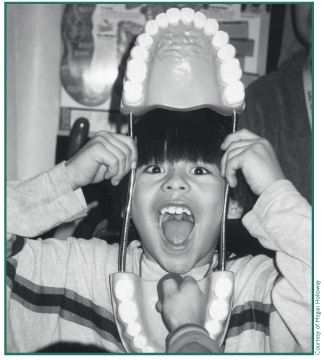
Courtesy of
Megan Holloway
|
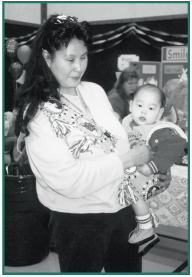
Carol Evans and Alexander
at the 2001 Health Fair.
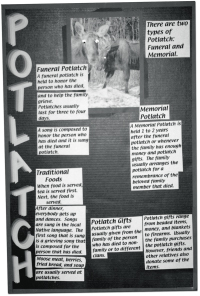
|
PROJECTS
- Develop a community calendar using recipes, harvest
times and practices, stories (anecdotal or traditional),
and information that Elders have told them. Have
students break into groups, or individually choose
a month and a food to represent. What would they
eat and or harvest at that time of year? Encourage
the students to learn the words, in their traditional
language (where relevant) and include these words
on the calendar.
- Guide the students to create a diagram of an
animal or plant. What parts are eaten? What parts
are non-edible but used to make something important
for the community? Have the students learn the
words, in their traditional language, for parts
of an animal and phrases that describe interactions
with the animal. Use the student knowledge and
community help to cook a meal for Elders and/or
prepare a gift with a local plant or animal resource.
For grades 5-12:
Make a listening station on the computer
with the words spoken in the language and in English
or make posters including a diagram of the animal
with words and phrases.
- Develop a Bingo game or a similar game using
the traditional language and local foods. Include
pictures so that Elders and non-reading community
members may also participate. Have the caller say
the words in the traditional language. Also, refer
to the website listed in the "Teacher note" at
the beginning of the chapter for other game options.
- Prepare a traditional food that the students
may not have tasted or made before.
Discussion Ideas:
- Why is it important to follow the guidelines
of our Elders when you go hunting? Have the circumstances
changed for hunting/fishing/snaring/trapping traditional
foods? If so, how have circumstances changed?
- What are some of the events you have that include
local food?
- How might a diet in local foods help with common
illnesses that are only recently problems for people?
How might the practices of harvesting these foods
that you discussed with an Elder help prevent some
of these illnesses? (Diabetes, heart disease, malnutrition,
etc.)
- How did your Elders learn how to harvest food?
Discuss the role of science in making tools, preparing
food, and knowing how to travel on land and in
water. Also, discuss spirituality, sharing, interactions
with the natural world, and celebrations. What
do these values and activities have to do with
harvesting food?
- With the guidance of an Elder, explore with students
what elements have been catalysts for change away
from the traditional storage practices?
|
Teryn Pence draws local plants
after taking a walk at the Chistochina school.
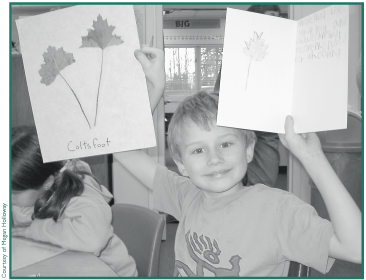
Courtesy of Megan Holloway
Food Guide Pyramid
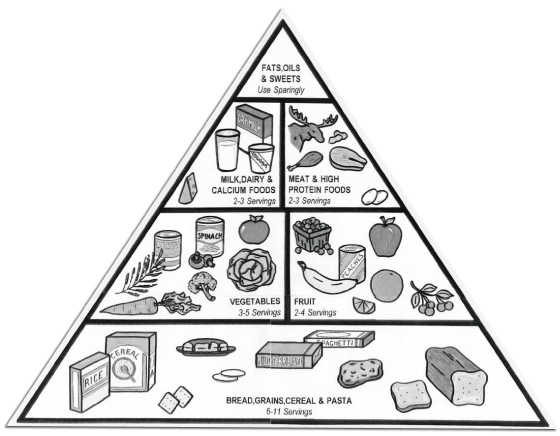
|
HOW TO USE THE DAILY GUIDE
|
Use the Food Guide
Pyramid to help you eat better every day...
the Dietary Guidelines way. Start with
plenty of Breads, Cereals, Rice and Pasta;
Vegetables; and Fruits. Add two to three
serving from the Milk group and two to
three servings from the meat group.
|
Each of these food
groups provides some, but not all of the
nutrients you need. No one food group is
more important than another - for good
health you need them all. Go easy on fats,
oils, and sweets, the foods in the small
tip of the Food Guide Pyramid.
|
WHAT COUNTS AS ONE
SERVING?
|
Bread, Cereals,
Rice, and Noodles
1 slice of bread
1 piece of pilot bread
1/2 cup of cooked cereal
1 ounce of cold cereal
1/2 cup of cooked rice
1/2 cup of cooked noodles
|
Milk, Yogurt,
Cheese, and Calcium Foods
1 cup of milk
1 cup of yogurt
1 1/2 to 2 ounces of cheese
1 bowl of fish head soup
|
|
Vegetables
1/2 cup of chopped raw or cooked
vegetables
1 cup of leafy raw vegetables
|
Meat, Birds,
Fish, Dry Beans, Eggs and, Nuts
3 ounces of cooked lean meat
3 ounces of cooked bird
3 ounces of cooked fish
1-6 inch strip of dried fish
Count 1/2 cup of cooked beans, or 1 egg, or 2 tablespoons
of peanut butter as 1 ounce of lean meat (about 1/3 serving)
|
|
Fruits
1 cup of berries
1 piece of fruit
1 wedge melon
3/4 cup 100% real fruit juice
1/2 cup canned fruit
1/4 cup of dried fruit
|
Fats, Oils,
and Sweets
LIMIT CALORIES FROM THESE FOODS
especially if you need to lose weight
|
|
How many servings
to you need each day?
|
|
Women & some
older adults
|
Children,
teen girls, active women, most
men
|
Teen
boys & active
men
|
|
Calorie
level
|
about
1,600
|
about
2.200
|
about
2.800
|
|
Bread
group
|
6
|
9
|
11
|
|
Vegetable
group
|
3
|
4
|
5
|
|
Fruit
group
|
2
|
3
|
4
|
|
Milk group
|
**2-3
|
**2-3
|
**2-3
|
|
Meat group
|
5 ounces
|
6 ounces
|
7 ounces
|
* These are
the calorie amounts if you choose
low fat, lean foods from the 5 major
food groups and use foods from the
fats, oils and sweets group sparingly.
** Women who
are pregnant or breastfeeding, teenagers,
and young adults to age 24 need 3
servings.
|
|
Handout
revised by 1998-1999 AP4 Dietetic Interns;
Artwork done by Jenny Biggs
Approved by Nutrition
Education Materials Coordinating Committee (NEMCC)
6/8/99- AK FGP
The information
in this handbook was adapted from the USDA's Food
Guide Pyramid,
U.S. Department of Agriculture, Human Nutrition Information
Services, 1992.
|
|
 The
University of Alaska Fairbanks is an Affirmative
Action/Equal Opportunity employer, educational
institution, and provider is a part of the University of Alaska
system. Learn more about UA's notice of nondiscrimination. The
University of Alaska Fairbanks is an Affirmative
Action/Equal Opportunity employer, educational
institution, and provider is a part of the University of Alaska
system. Learn more about UA's notice of nondiscrimination.
Alaska Native Knowledge
Network
University of Alaska Fairbanks
PO Box 756730
Fairbanks AK 99775-6730
Phone (907) 474.1902
Fax (907) 474.1957 |
Questions or comments?
Contact ANKN |
|
Last
modified
August 17, 2006
|
|
|